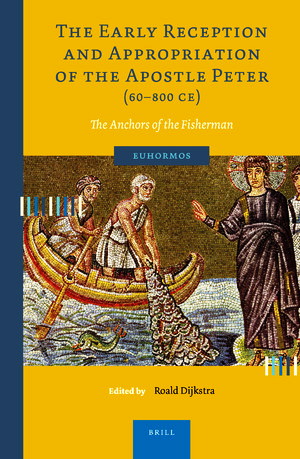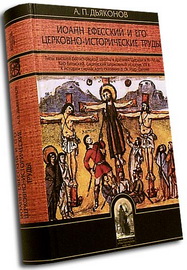
The Early Reception and Appropriation of the Apostle Peter (60–800 CE)

Already we hold most trusty sureties for this hope, for already there reign
here the two chiefs of the apostles, the one he who called the Gentiles,
while the other who occupies the foremost chair opens the gates of eternity
which were committed to his keeping.
Prudentius, Peristephanon 2.457–641
These verses are exclaimed by Rome’s greatest “native” saint Laurentius in a poem by Prudentius. By doing so, the Roman saint testifies to the prominence of two Christians saints even more powerful and authoritative than himself: Peter and Paul. Prudentius makes Laurentius praise the apostle Peter in a most honourable way by referring to his extraordinary power: he holds the primary see and controls the doors of heaven. Both on earth and in the hereafter, Peteris in charge. At the same time, Peter’s authority in Rome (and that of Peter’s self-proclaimed successors) is enforced by its connection to the Roman local saint Laurentius. These verses are just one example out of many that confirm Peter’s prominent position within the religious, political and cultural Christian landscape of late antiquity.
Ever since the first century, Christians have engaged heated discussions about the nature and implications of Peter’s special position in the Church (based mainly on Matt. 16.16–19). The historicity of the life of Peter as described in the books of the New Testament and some influential apocryphal texts (mainly the Acts of Peter) was hardly ever doubted in the period of our concern (1st–9th century CE). This is the reason why the reception of the apostle is much more important for the history of Christianity than the “historical Peter”. The figure of Peter, i.e. the constructed image of a man equal to one of the apostles with this name, mentioned in the gospels but also in many other writings, images and traditions in (late) antiquity and the early middle ages, is the main subject of this book. In this contribution, the role of Peter as an anchor is explained, contextualised, and related to all the different other contributions this volume consists of.
1. Anchoring the Apostle Nautical metaphors are not uncommon in the New Testament: Jesus’ call of Peter and his brother Andrew – proclaiming to make them fishers of men (Matt. 4.19) – is among the most famous examples of this biblical feature. It is another nautical, but not religiously charged, metaphor that is used as a starting point of the investigations towards the figure of Peter in this book: that of Anchoring Innovation. This concept, claiming that innovations have higher chances of success when they are successfully embedded – or anchored – in something known and familiar, has proven to be particularly insightful when applied to the role of Peter in the dynamics of late antiquity and the early middle ages.
Shortly after the fisherman from Galilee had left his fishing boat, he became an anchor for many people across the Roman Empire. Traditions around Peter were so strong (i.e. anchored firmly), that already soon after his death people adhered to them and successfully employed them for diverging purposes. As a result, persons from all social strata and backgrounds could have recourse to the same figure: the apostle Peter, martyred in Rome. At the same time, firmly grounded traditions about Peter also restricted his use as an anchor in future times, in a process that Olivier Hekster has characterized as the “constraints of tradition”. Not everything was possible. One example is the place of Peter’s martyrdom. Whereas Peter’s stay (and subsequent martyrdom) in Rome has aroused much debate in modern scholarship, not even the slightest doubt about Peter’s Roman martyrdom seems to have existed in antiquity. The tradition was accepted very early and apparently accepted without discussion. No city other than Rome could claim the blood of Peter (and Paul), as Damasus would famously do in his epigram discussed below. The extraordinary prestige of Rome explains why the story of Peter’s Roman martyrdom is first found in Eastern texts or why Western liturgical sources outside Rome do not put less emphasis on Peter’s Romanness (see Rose’s contribution to this volume). It was the uncontested nature of this important tradition of Peter that created an anchor stable enough to become the stronghold of a great variety of other traditions, political claims, architectural accomplishments, visual representations, liturgical developments and literary responses. This was not surprising, since references to great men from the past were abundant both in the Greco-Roman and Jewish tradition. Peter himself was anchored in Moses, the leader of the Jewish people, in early Christian art (see e.g. Dresken-Weiland’s contribution). Moreover, Peter also was first, in several respects: the first man among his fellow disciples of Christ, the first bishop of Rome and the first known martyr in the city. This primacy made him an even more attractive anchor. The following paper by Hekster will further explain some of the anchoring mechanisms at work in late antiquity.
Roald Dijkstra - The Early Reception and Appropriation of the Apostle Peter (60–800 CE) - The Anchors of the Fisherman
Leiden; Boston: Brill, 2020 - 342
ISBN 978-90-04-42567-5 (hardback)
ISBN 978-90-04-42568-2 (e-book)
Roald Dijkstra - The Early Reception and Appropriation of the Apostle Peter (60–800 CE) - The Anchors of the Fisherman - Contents
Forewordi
Ineke Sluiter
Prefaceii
Roald Dijkstra
List of Illustrations
Abbreviations
Contributors
PART 1. Anchoring the Apostle: the Volume and Its Concept
1 Peter, Popes, Politics and More: the Apostle as Anchor
Roald Dijkstra
2 Ruling through Religion? Innovation and Tradition in Roman Imperial Representation
Olivier Hekster
PART 2. Anchoring the Authority of Peter
3 From Petrus to Pontifex Maximus
John R. Curran
4 The Multiple Meanings of Papal Inscriptions in Late Antiquity and the Early Middle Ages
Thomas F. X. Noble
5 Attitudes to Jewish and Roman Power in the Gospel and Acts of Peter
Markus Bockmuehl
6 Peter, the Visionary before the Pope: Early Receptions of the Apostle in Marginal Communities
Régis Burnet
PART 3. Anchoring Peter in Art and Poetry
7 The Role of Peter in Early Christian Art: Images from the 4th to the 6th Century
Jutta Dresken-Weiland
8 The Death of Peter: Anchoring an Image in the Context of Late Antique Representations of Martyrdom
Markus Löx
9 Romulus and Peter: Remembering and Reconfiguring Rome’s Foundation in Late Antiquity
Mark Humphries
10 Sedulius’ Peter: Intention and Authority in the Paschale carmen
Carl P. E. Springer
PART 4. Anchoring the Cult of Peter
11 Peter without Paul: Aspects of the Primordial Role of Simon Peter in an Early Christian Context
Annewies van den Hoek
12 The Architectural Appropriation of the Apostle Peter by the Early Christian Popes
Kristina Friedrichs
13 The Cult of Peter and the Development of Martyr Cult in Rome. The Origins of the Presentation of Peter and Paul as Martyrs
Alan Thacker
14 Anchoring the Rock: the Latin Liturgical Cult of Peter in Late Antiquity and the Early Middle Ages
Els Rose
General Bibliography
Index locorum
General Index




Комментарии (1 комментарий)
Спасибо за хорошую книгу с приклеенной обложкой! Петр действительно оказался "неодоцененным"...